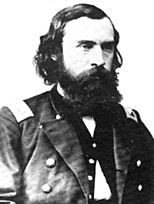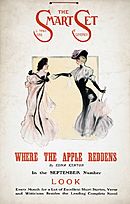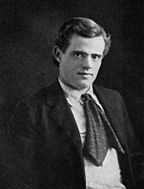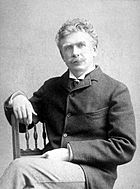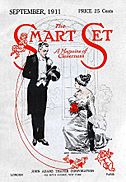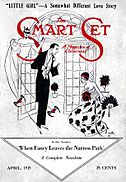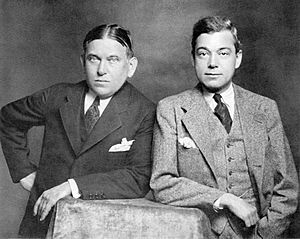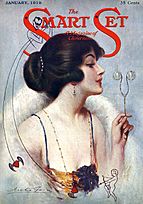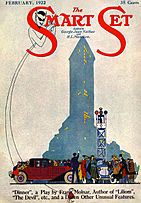The Smart Set facts for kids
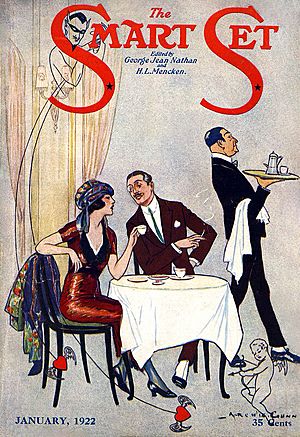
Cover of January 1922 issue
by illustrator Archie Gunn |
|
| Categories | Literary magazine |
|---|---|
| Circulation | 250,000 (in 1925) |
| Publisher | William d'Alton Mann (1900–1911) John Adams Thayer (1911–1914) Eugene Crowe and Eltinge F. Warner (1914–1930) |
| First issue | March 1900 |
| Final issue | July 1930 |
| Country | United States |
| Based in | New York City |
| Language | English |
The Smart Set was a popular American magazine. It was published from March 1900 to June 1930. The magazine was based in New York City. It became very famous during the Jazz Age.
Two important editors, H. L. Mencken and George Jean Nathan, helped many new writers get started. They gave these writers a chance to reach a large audience. After a disagreement about an article, Mencken and Nathan left in 1924. They started their own magazine, The American Mercury.
Later, the magazine was sold to William Randolph Hearst. Even though more people read it, the quality of the stories went down. After the Wall Street Crash of 1929, the magazine could not survive. It stopped being published in June 1930. Years later, a critic named Louis Kronenberger called The Smart Set one of the best magazines ever. He said it helped shape American culture.
Contents
The Smart Set's Beginnings
In 1900, Colonel William d'Alton Mann started The Smart Set. He was a veteran of the American Civil War. Mann wanted this new magazine to be a cultural partner to his other magazine, Town Topics.
Town Topics was known for sharing gossip about rich people in New York City. Mann wanted The Smart Set to feature works by and for the city's wealthy and fashionable people. He called it "The Magazine of Cleverness."
The first issue came out on March 10, 1900. Arthur Grissom, a young poet, was the first editor. He set up the magazine's style. Each issue had a short novel, a play, poems, and witty sayings. The first cover showed a dancing couple. It cost twenty-five cents. Early writers included famous poets like Ella Wheeler Wilcox.
Grissom was the first to publish stories by O. Henry in the magazine. Sadly, Grissom died in 1901. Marvin Dana then became the editor. He worked with two associate editors, Charles Hanson Towne and Henry Collins Walsh.
Dana left in 1904, and Towne took over. Towne encouraged new writers like James Branch Cabell. He also worked with famous authors such as Jack London and Ambrose Bierce. Under Towne, The Smart Set became known for its light, satirical tone. It often featured stories about social life and love.
By 1905, the magazine had 165,000 readers. However, its popularity dropped after some issues with Mann's other magazine. Towne resigned in 1908.
Colonel Mann then became editor with Fred Splint. They tried to make the magazine popular again. In 1908, Splint hired H. L. Mencken to write book reviews. Mencken was a newspaperman from Baltimore. His reviews were very popular and lively. He soon became a very important critic in America.
In 1909, George Jean Nathan joined as the drama columnist. He became a very influential theater critic in New York. Nathan was just as bold and witty as Mencken. Together, Mencken and Nathan made The Smart Set a must-read for thinkers. Their writing helped the magazine become a part of literary history.
The Thayer Years and New Directions
In 1911, Colonel Mann sold The Smart Set to John Adams Thayer. Thayer was a rich man who had made his money in advertising. He hoped owning the magazine would help him join New York's high society. But the magazine's reputation was not good.
Thayer became the editor-in-chief. He added a new slogan: "Its Prime Purpose is to Provide Lively Entertainment for Minds That Are Not Primitive." This slogan did not help much. However, by 1912, younger, more rebellious readers started enjoying the magazine.
In 1913, Thayer made Willard Huntington Wright the new editor. Wright was a Harvard graduate. He wanted to make The Smart Set a new kind of magazine for America. He aimed for something like the artistic magazines found in Europe.
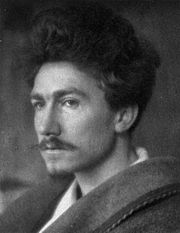
Wright's time as editor was short but important for art. He had full control over the magazine. He started publishing new and experimental works. He even hired Ezra Pound to find new talent from other countries. Authors like D.H. Lawrence and Joseph Conrad appeared in the magazine.
This new style caused problems. Fewer people bought the magazine, and advertisers stopped supporting it. Wright was also spending too much money on authors. Because of this, Thayer fired Wright in 1914. He announced that the magazine would go back to more traditional stories.
By then, the magazine was in financial trouble. Thayer gave ownership to Colonel Eugene Crowe. Even so, Wright's changes had brought in a new, intellectual audience. Famous writers like Sinclair Lewis and F. Scott Fitzgerald read it. It also caught the eye of critics and journalists. Harold Ross, who later started The New Yorker, was inspired by The Smart Set.
Mencken and Nathan's Golden Age
Colonel Crowe gave control of The Smart Set to Eltinge Warner. Warner then made Mencken and Nathan co-editors. They had complete artistic freedom. Warner handled the business side, like sales and advertising.
Mencken and Nathan made some changes to save money. They moved to a smaller office and kept only a few staff members. They also started other magazines to earn more money. For example, they launched The Parisienne in 1915. This magazine published stories that were not quite right for The Smart Set. The money from The Parisienne helped pay for The Smart Set. They did this again with Saucy Stories and Black Mask.
Their time as co-editors was a great period for new literature. They created a unique place for American fiction. This made the magazine very important for literary growth in the 1910s and early 1920s. About 40,000 to 50,000 copies were sold. This made it one of the most widely read literary magazines.
Mencken and Nathan especially wanted young readers. These readers felt restless after World War I. The magazine featured works by many famous writers. These included Edna St. Vincent Millay, Theodore Dreiser, and Eugene O'Neill. In 1915, The Smart Set published two stories by James Joyce. This was the first time his work appeared in America. The magazine also introduced F. Scott Fitzgerald in 1919.
Besides new writers, the editors were known for making fun of American culture. Their satirical style became more and more controversial. This eventually led to their departure from the magazine.
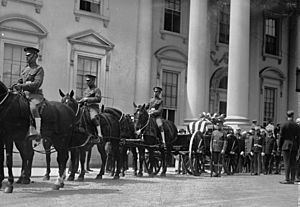
Mencken and Nathan's time at The Smart Set ended in 1923. They wanted to publish a satirical piece about President Warren G. Harding after he died. Harding's funeral procession was very emotional for the country. Mencken and Nathan felt the media was being fake. They wanted to write about the president in death just as they had in life.
However, the magazine's printers saw the article. They told the owner, Eltinge Warner. Warner was very angry. He demanded that the editors remove the piece. Warner said he would sell the magazine within a year. This meant Mencken and Nathan no longer had full control. They decided to leave and start their own magazine, The American Mercury, with Alfred A. Knopf.
The Magazine's Final Years
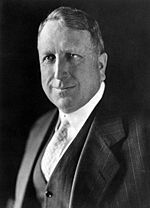
Before leaving, Mencken and Nathan suggested Morris Gilbert as their replacement. Gilbert did not know that Warner planned to sell the magazine. Under Gilbert, the magazine went back to its older style. It was less bold than during Mencken and Nathan's time.
Gilbert's time as editor was short. In 1924, Warner sold the magazine to William Randolph Hearst. Hearst was a very powerful newspaper owner. He immediately put George D'Utassey in charge. Gilbert resigned soon after.
Under Hearst, the magazine focused more on making money. It also featured simpler, more traditional stories. D'Utassey changed the subtitle to "True Stories from Real Life." The magazine moved away from unique literature and satire. Even though the content changed, Hearst promoted the magazine a lot. Its readership grew to 250,000 by 1925.
In 1929, The Smart Set joined with another Hearst magazine, McClure's. It became The New Smart Set. Margaret Sangster became the editor. The magazine was now aimed at young women. Its new subtitle was "The Young Woman's Magazine."
However, the Wall Street Crash of 1929 caused a big economic downturn. The magazine could not survive the tough times. It stopped publishing in June 1930.
The Smart Set's Lasting Impact
In 1934, some of the best writings from the magazine were put into a book. It was called The Smart Set Anthology. That same year, critic Louis Kronenberger praised the magazine. He wrote in The New York Times Book Review that it was one of the greatest literary magazines.
Kronenberger said The Smart Set had a big impact on American culture. He wrote that it felt like it was "making literary history." He believed it was "teaching a literary America that went about on all fours how to walk." This means it helped American writing grow and become more sophisticated.
In 2007, Drexel University started an online cultural journal. They named it The Smart Set. It shares some ideas with the original magazine. It even uses a pen name, Owen Hatteras, that Mencken and Nathan used. However, this new journal is not officially connected to the old one.
Editors of The Smart Set Magazine
- Arthur Grissom (1900–1901)
- Marvin Dana (1902–1904)
- Charles Hanson Towne (1904–1907)
- Fred C. Splint (1907–1908)
- Norman Boyer (1909–1911)
- Mark Lee Luther (1911–1912)
John Thayer era
- John Adams Thayer (1911–1913)
- Willard Huntington Wright (1913–1914)
Eltinge Warner era
- H. L. Mencken and George Jean Nathan (1914–1924)
- Morris Gilbert (1924)
William Randolph Hearst era
- F. Orlin Tremaine (1924–1925)
- William Charles Lengel (1925–1928)
- T. Howard Kelly (1928–1929)
- Margeret Sangster (1929–1930)
Writers Who Contributed
- Maxwell Anderson
- Sherwood Anderson
- Djuna Barnes
- Ambrose Bierce
- Bliss Carman
- Willa Cather
- Theodore Dreiser
- Lord Dunsany
- F. Scott Fitzgerald
- Ford Madox Ford
- Zona Gale
- Richard Le Gallienne
- Dashiell Hammett
- Ben Hecht
- O. Henry
- Aldous Huxley
- Robinson Jeffers
- James Joyce
- Harry Kemp
- D.H. Lawrence
- Sinclair Lewis
- Anita Loos
- Jack London
- Edna St. Vincent Millay
- Eugene O'Neill
- Dorothy Parker
- Ezra Pound
- John Reed
- Clinton Scollard
- Carl Van Vechten
- S.S. Van Dine
- Ella Wheeler Wilcox
Images for kids


